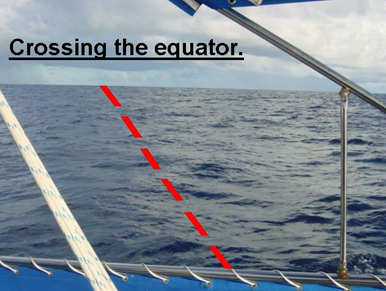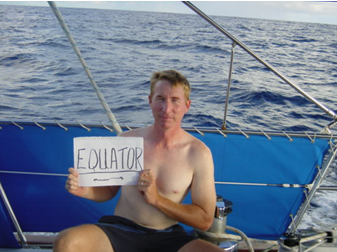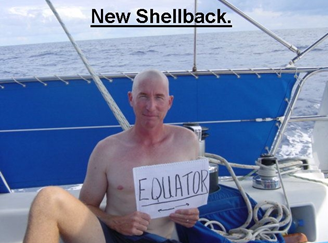- Boat
- Articles
- About
- Tehani-li Logs
- 2004
- Uligan Maldives
- Man, Oh Man, Oman
- Eritrea: The Nicest Place You’ve Never Heard Of
- Cruising Notes: Oman to Eritrea – From Pirates to Cappucinos
- Old Testament Sudan
- Egypt: Legend, Myth and Reality
- Thoughts on Cruising the Red Sea
- Greece: Civilization Again
- Montenegro
- Malta
- Sardinia, Italy
- Barcelona, Spain
- 2003
- 2002
- 2001
- 2004
- Contact
Crossing the Equator
We are now in the Southern Hemisphere. No, this is not where everyone goes to “cotillions,” wears overalls and says things like “hey, y’all.” We have finally crossed the equator under sail. In sailing this is a big deal, especially for the first time. And this was our first time.
Ever since man first shoved off from shore on a log, the ocean did and still does hold terrors and beasts unknown on land. To cross the equator at sea and go from one hemisphere to another required ceremonies to mark the occasion and appease the gods, in this case King Neptune, ruler of all oceans (and father of “Ariel,” the little mermaid in the Disney film, for those of you with young children).
Pagan ceremonies have been carried out for centuries on the decks of ships initiating first timers “across the line” into the brotherhood. Once across and thus initiated you are what is known as a “shellback.”
This is what the equator looks like.

All ceremonies have their quirks but the most important part of this one to ensure a continuing safe passage is to toast Neptune in his reign with the best bottle of booze aboard. In our case this was a bottle of French champagne. Neptune gets the first toast and you pour a generous amount into the sea.
It is important not to be cheap here – we gave him at least half. The rest is swigged by the crew. Neptune is supposed to come on board and hand out gifts to the new shellbacks. Since there were only two of us I gave Ariel a sarong I had purchased for the occasion back in Sri Lanka.
But I didn’t dress up as Neptune with the fork, and hair and flowing robes like they do with larger crews. The person who plays the part of Neptune also has to be a shellback already and since my only time across the line was in a Boeing 747, I didn’t think I really qualified.

Other parts of the ceremony require cutting hair. Ariel only let me snip a TINY piece of hers. I shaved my head. We were also able to get crossing the equator on film. The picture (bad quality, too excited) shows the coordinates on our GPS. Look where it says “S” that means “South” and all the zeroes following it are the equator. I quickly jumped up on deck and snapped a shot of it going by too. A very rare photo.


After all that excitement we arrived in the southernmost atoll of the Maldives, Addu. The “town,” such that it is, is called Gan and is very, very laid back. A sleepy place. In fact the only energy apparently expended here is by the absolutely HUMONGOUS fruit bats soaring around in the day looking like pterodactyls from Jurassic Park.
These suckers must have wingspans of a meter of more. If I were less than a hundred pounds I wouldn’t go outside alone. In fact they made Ariel, at 110 LBS, a little uneasy.
We will spend only a couple of days here as the season is late and we need to head south to the Chagos Archipelago. OK, we have mentioned Chagos before and for non-yachties it is a place you have never heard of and wouldn’t care. I certainly didn’t know anything about it until we came out here.
But Chagos IS “yachtie paradise,” and people sail out here from all over the world to spend months on these uninhabited tropical islands right in the middle of the Indian Ocean. They are officially part of the BIOT, the British Indian Ocean Territory, and are nominally administered by the UK. Diego Garcia, as I mentioned before, is a huge US airbase that is part of the island group.
Ever keen to make a buck, her majesty’s government kicked all the natives off Chagos, known as “Chagosians” (distant cousins of the Romulans, perhaps) and planted them in the Seychelles many years ago. I don’t know what Uncle Sam pays in rent but for us it is free, well almost.
I understand we have to pay $50 to check in with a British warship that comes around every 6 weeks or so but that is pretty cheap compared to other places we’ve been.
There is not much to do there but eat fish and hang out. The cruisers have built their own community and organize group fishing expeditions and barbecues on the beach for any and all reasons. Last month we heard on the SSB radio, they all celebrated Mexican Independence Day, Cinco de Mayo, in a big way and I don’t think there are any Mexicans out there.
We will have to check it out. I think we will spend a month in Chagos. “Uninhabited” means just that so no internet cafes. We will next update the website from the Seychelles in 6 weeks or so. (Or so I thought at the time!).

